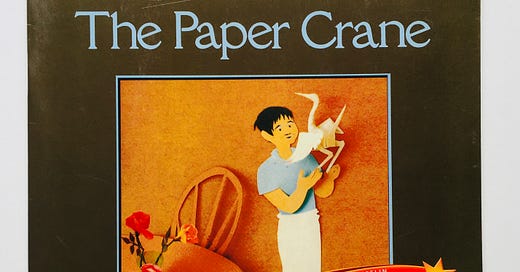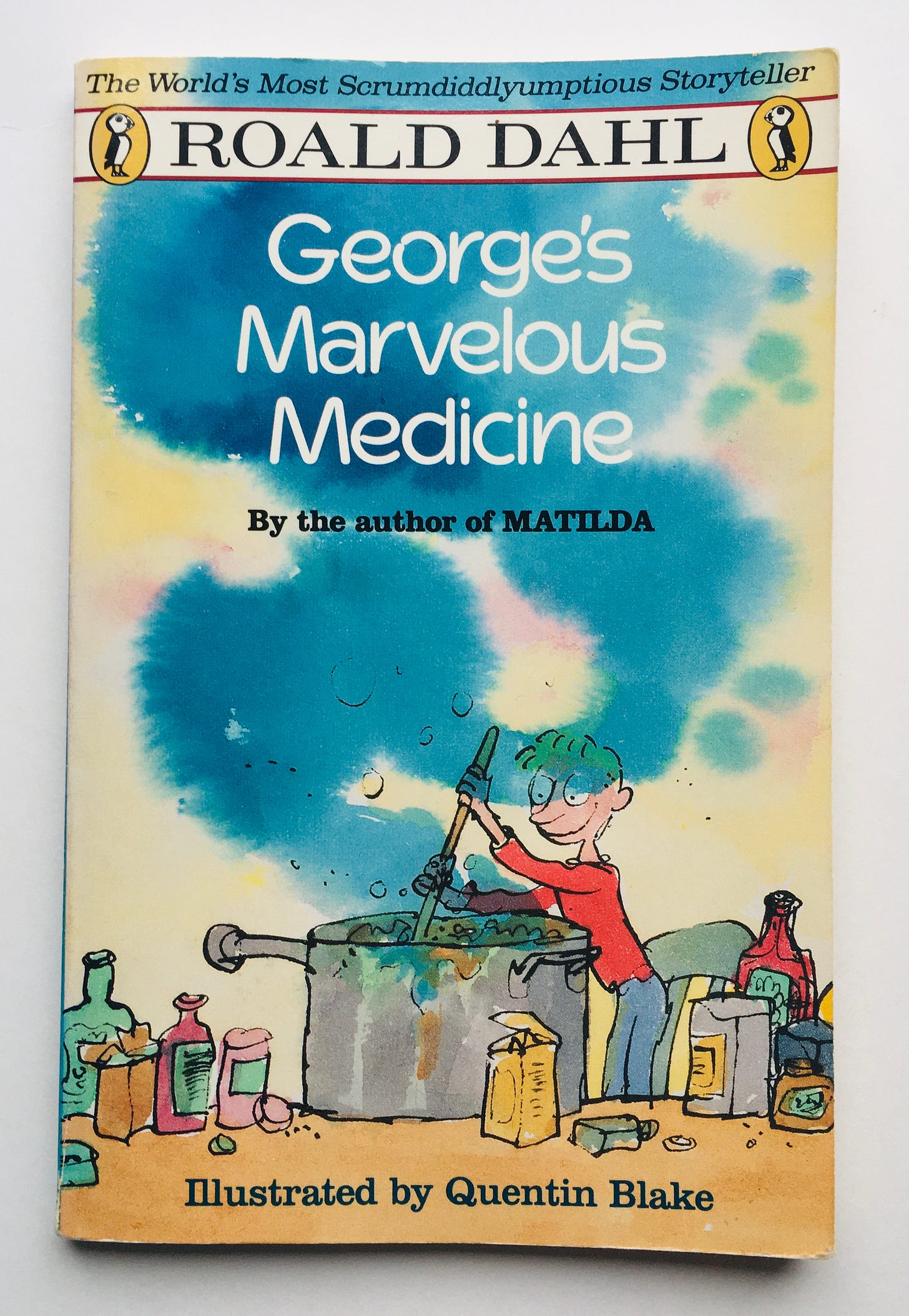Hi there! Congratulations on arriving at Wednesday. We are still here! Together! It’s not nothing.
(That’s all I’ve got today, beautiful people. Let’s get started.)
The Paper Crane by Molly Bang (1985)
This is the story of a man “who loved to cook good food and loved to serve it” — he works happily day and night in his restaurant, until circumstances out of his control devastates the business. One morning a stranger with “an unusual, gentle manner” arrives, and though he has no money, the owner of the restaurant invites him in and cooks him “the best meal he could make.” In return, the stranger offers his own type of thanks — a folded paper crane that he claims will come to life and dance at the clap of one’s hands.
This is just what happens, and because of the unbelievability of this, guests flock back to the restaurant, restoring the business to its previous state of success until eventually, the stranger returns — only this time he climbs on the crane’s back, heads out the door, and flies away. But the restaurant persists, with customers returning to hear the story of the crane again and again.
This book is, like many from Bang, is a bit odd, a bit magic, and contains more than a bit of mystery. But, like her other stories, this is also what makes it work so well: there is so much to wonder about — who is the stranger, and where did he come from? Why did he help the restaurant owner? Where did the stranger and the crane fly off to when they left? Is a crane even strong enough to carry a large human? — it holds great appeal for children of various ages.
Bang, who wrote an entire book about the structure of pictures and how they determine our emotional response (Picture This) is especially, maybe even uniquely adept at depicting the way her characters feel, and this is as true here as in any of her other work. How she manages to construct such emotive facial expressions through collage is beyond me but she does, and it’s kind of fascinating.
I love this book for its quietude but also its themes of generosity, and the necessity of holding one’s gifts lightly in one hands. It feels very much like an old folktale, only with more space for interpretation and possibility.
Mice and Beans by Pam Muñoz Ryan, illustrated by Joe Cepeda (2001)
“Rosa Maria lived in a tiny house with a tiny yard. But she had a big heart, a big family, and more than anything, she loved to cook big meals for them.” The week that she is preparing for her youngest grandchild’s birthday party, she takes extra care to tidy her kitchen and make sure everything is in order for the celebration — little does she know, the mice who live in her house are preparing for the birthday party in a special way of their own.
As such, Rosa Maria’s things keep disappearing — on Monday it’s a freshly-ironed napkin, on Thursday her favorite wooden spoon — along with the mousetraps she keeps setting, because, as her mother had always said, “When there’s room in the heart, there’s room in the house, except for a mouse.” The days go by, the hijinks continue, until Saturday, the day of the party, when the children go to break the piñata and it’s filled with candy Rosa Maria does not remember depositing herself.
Kiddos delight in this fun story, with its repetitive elements, smattering of Spanish words, and Cepeda’s glowing oils over acrylic under-paintings on board, which reveal to them — before Rosa Maria — the tiny mystery helpers of the rodent variety who make the party a success. Learning to live in harmony — and, indeed, helping one another — is a worthwhile pursuit and a timeless lesson for us all. All the better to enjoy learning it.
Bun Bun Button by Patricia Polacco (2011)
It’s no secret that I am a big fan of Patricia Polacco (I actually have yet to meet anyone who is not a big fan, once they get to know her work) and along with the other titles of hers I have reviewed in this newsletter (Mommies Say Shhh! in issue No. 3, Luba and the Wren in No. 36, and Rechenka’s Eggs in my 2021 special edition on Easter), Bun Bun Button is amongst my family’s favorites.
It’s the story of a little girl named Paige who loves spending time at her Gramma’s house, especially cuddling in Gramma’s big Old Blue Chair with a whole menagerie of pets. But Paige longs for something of her own to snuggle, so when Gramma sews her a soft, sweet little bunny, Paige is delighted, and brings Bun Bun Button along with her everywhere. One day during playtime, though, Paige ties Bun Bun Button to a balloon and, of course, the beloved stuffed animal gets carried away. Paige is heartbroken and the reader despairs for what might happen as Bun Bun travels higher and higher into the sky and eventually space, encountering a goose and the wide black sky, until a mysterious — Gramma would say lucky — turn of events returns Bun Bun back where she belongs, safe in Paige’s loving arms.
As ever, Polacco’s pencil and marker illustrations are full of life and feeling — I can’t imagine what a Polacco story would be without Polacco’s distinctive, evocative images. Here she shows the special bond between grandparent and child as well as between child and precious security object in a way that shows the very real, very deep love and comfort to be found in each. This is a warm, reassuring story.
George’s Marvelous Medicine by Roald Dahl, illustrated by Quentin Blake (1981)
A Roald Dahl title might seem like a dubious recommendation, if only because he’s so famous and beloved (there are other reasons, but these are the big ones) but I find many people who weren’t Dahl fans as children (I was, and rabidly so) either haven’t explored or simply aren’t aware of some of his lesser-known titles.
Enter George’s Marvelous Medicine, which is the perfectly wild, hilarious tale of a boy who takes revenge on his horrible grandmother by re-making her daily medicine into the most disgusting, viscous, life-changing slop imaginable. And change her life it does — not only does it send her through the roof, quite literally, it has a phenomenal and outrageous effect on one of the family’s chickens, which causes George’s father to get dollar signs in his eyes as he realizes they could make a fortune off the creation of giant animals.
I’ve heard criticism that the ending of this tale is underdeveloped and abrupt, and I suppose, if you’re a reader of Dahl’s whole body of work, it is — it’s a quick-and-dirty read but no less enjoyable for being so (and as always, Blake’s scratchy, untamed pen-and-ink illustrations match Dahl’s naughty, undomesticated imagination and wit — I can’t imagine one without the other). The mornings I read this to my children at breakfast they literally hung on my arms when it came time to stop, begging me to continue (I did, of course, with no regrets). Any book that makes the children giggle and clamour for more is a winner to me.
This one holds up after 30 years and will likely hold up for 30 more, keeping multiple generations of readers/listeners on the edge of their seats (until they fall off from disbelief, and then laughter).
A Beautiful Day in the Neighborhood: The Poetry of Mister Rogers by Fred Rogers, illustrated by Luke Flowers (2009)
The poetry of Mr. Rogers? Well, the man sang an original song during every single episode of the 39-year run of Mister Rogers’ Neighborhood, among the most beloved children’s television programming of all time, and without the music the text is poetic, to be sure. Nevertheless, when I first saw this title a few years ago at Costco I was skeptical: could you call his songs poetry? It turns out yes, you can.
All of the goodness of the original show (as well as that of Daniel Tiger’s Neighborhood, the second generation of Mr. Rogers’ legacy and hands down the #1 most-watched show of all time in our home) — all of the deeply loving, accepting, reassuring messaging — is contained in this book, which includes the full text of the songs (though not the music) accompanied by Flowers’ vibrant, cheerful digital illustrations.
Is it, like, the most beautiful poetry ever? No, and that’s most noticeable in the repetitive verses, but it is surprisingly heartwarming (and so very easy) to read these aloud — to say, in essence, over and over, the things that Mr. Rogers conveyed to children with his every word and action, from deep down in his soul: “I see you, I hear you, it’s okay to feel what you feel. I like you just the way you are.”
I recommend this one, especially if you are still skeptical about poetry, still don’t “get it” (here’s a secret: there’s nothing to get!), still don’t think poetry is for you or your kiddos — it’s a good, simple way to say important things, and hey, it might just be your on-ramp to poetry. (On-ramping grownups to poetry for children being one of my top goals here).
This title is so sweet, and full of every good thing one could want their child to hear.
That’s all from me today. Thanks for reading!
Sarah








